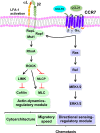A meta-analysis indicates that the regulation of cell motility is a non-intrinsic function of chemoattractant receptors that is governed independently of directional sensing
- PMID: 36341452
- PMCID: PMC9630654
- DOI: 10.3389/fimmu.2022.1001086
A meta-analysis indicates that the regulation of cell motility is a non-intrinsic function of chemoattractant receptors that is governed independently of directional sensing
Abstract
Chemoattraction, defined as the migration of a cell toward a source of a chemical gradient, is controlled by chemoattractant receptors. Chemoattraction involves two basic activities, namely, directional sensing, a molecular mechanism that detects the direction of a source of chemoattractant, and actin-based motility, which allows the migration of a cell towards it. Current models assume first, that chemoattractant receptors govern both directional sensing and motility (most commonly inducing an increase in the migratory speed of the cells, i.e. chemokinesis), and, second, that the signaling pathways controlling both activities are intertwined. We performed a meta-analysis to reassess these two points. From this study emerge two main findings. First, although many chemoattractant receptors govern directional sensing, there are also receptors that do not regulate cell motility, suggesting that is the ability to control directional sensing, not motility, that best defines a chemoattractant receptor. Second, multiple experimental data suggest that receptor-controlled directional sensing and motility can be controlled independently. We hypothesize that this independence may be based on the existence of separated signalling modules that selectively govern directional sensing and motility in chemotactic cells. Together, the information gathered can be useful to update current models representing the signalling from chemoattractant receptors. The new models may facilitate the development of strategies for a more effective pharmacological modulation of chemoattractant receptor-controlled chemoattraction in health and disease.
Keywords: actin; chemoattractant; chemoattractant receptor; chemoattraction; chemotaxis; directional sensing; migration; motility.
Copyright © 2022 Rodríguez-Fernández and Criado-García.
Conflict of interest statement
The authors declare that the research was conducted in the absence of any commercial or financial relationships that could be construed as a potential conflict of interest.
Figures




Similar articles
-
A spatially restricted increase in receptor mobility is involved in directional sensing during Dictyostelium discoideum chemotaxis.J Cell Sci. 2008 May 15;121(Pt 10):1750-7. doi: 10.1242/jcs.030692. J Cell Sci. 2008. PMID: 18469015
-
Chemoattractant action and molecular signaling pathways of Kit ligand on mouse primordial germ cells.Dev Biol. 2007 Jun 15;306(2):572-83. doi: 10.1016/j.ydbio.2007.03.031. Epub 2007 Mar 28. Dev Biol. 2007. PMID: 17467686
-
Eukaryotic chemotaxis: a network of signaling pathways controls motility, directional sensing, and polarity.Annu Rev Biophys. 2010;39:265-89. doi: 10.1146/annurev.biophys.093008.131228. Annu Rev Biophys. 2010. PMID: 20192768 Free PMC article. Review.
-
Modeling cell gradient sensing and migration in competing chemoattractant fields.PLoS One. 2011 Apr 29;6(4):e18805. doi: 10.1371/journal.pone.0018805. PLoS One. 2011. PMID: 21559528 Free PMC article.
-
Directional sensing during chemotaxis.FEBS Lett. 2008 Jun 18;582(14):2075-85. doi: 10.1016/j.febslet.2008.04.035. Epub 2008 Apr 29. FEBS Lett. 2008. PMID: 18452713 Free PMC article. Review.
Cited by
-
New genetic and epigenetic insights into the chemokine system: the latest discoveries aiding progression toward precision medicine.Cell Mol Immunol. 2023 Jul;20(7):739-776. doi: 10.1038/s41423-023-01032-x. Epub 2023 May 17. Cell Mol Immunol. 2023. PMID: 37198402 Free PMC article. Review.
References
-
- Wilkinson PC. Chemotaxis. In: Delves PJ, editor. Encyclopedia of immunology. Elsevier; Amsterdam, The Netherlands: (1998) 533–537.
-
- Franca-Koh J, Willard SS, Devreotes PN. G-Protein signaling in chemotaxis. In: Bradshaw RA, Dennis EA, editors. Handbook of cell signaling 2nd edition. Oxford: Academic Press; (2009). p. 1705–12.
Publication types
MeSH terms
Substances
LinkOut - more resources
Full Text Sources

